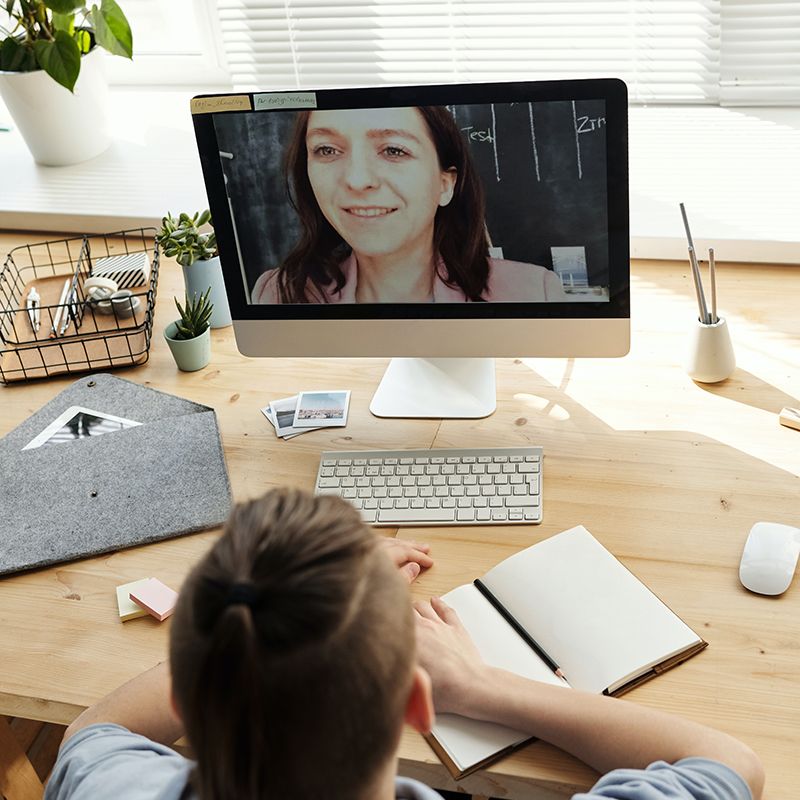
Image: Early this spring, educators across the country had to pivot quickly to teach online. Unfortunately, virtual education often lacks the human connection that teachers nurture. [Courtesy Julia M Cameron from Pexels]
This article was originally published in the Spring 2020 (vol. 49, no. 2) issue of Mercury magazine, an ASP members-only quarterly publication.
It’s challenging enough to engage a group of teenagers in an inquiry-based investigation when they are in the same room with you. This involves creating optimal cooperative groups, managing necessary materials, engaging in formative assessment and monitoring of student progress, and holding them accountable for their behavior. In the normal course of a day in the classroom, teachers circulate, engaging students. They encourage their students through questioning and assist with the manipulation of equipment, all the while keeping an eye and ear trained on what the rest of the class is doing. The metaphorical teacher has “eyes in the back of their head.”
The spring 2020 COVID-19 pandemic created a situation where classrooms even as small as 20 students had the potential to act as centers of distribution for the virus. As schools closed around the nation, teachers prepared to finish out the school year virtually, via a variety of platforms. These powerful tools — such as Zoom and WebEx — connect people geographically separated. Many organizations, the ASP included, have utilized them for years to conduct meetings and deliver professional development to educators in both formal and informal settings. The ASP has shown there is little difference in learning outcomes via virtual settings compared to in-person opportunities. The caveat: All of these opportunities were with motivated and experienced educators who already had a rich background in the content covered in the virtual professional development.
In the spring, teachers had to learn rapidly how to virtually engage a classroom of 20 first graders or 40 juniors. Virtual charter schools have claimed to accomplish this for years. The data however tell a different tale, with such charters achieving at much lower levels than in-person public schools. They are not the model to look to for guidance on how to shift daily in-person instruction to a virtual platform.
Science teaching is perhaps the most problematic area to shift to the virtual realm. The need to have students actively engaged while investigating natural phenomena, sometimes with specialized equipment, makes the online learning environment less rich than the physical classroom. It is difficult to imagine a teacher having students learn about chemical reactions experimentally in a home environment. In astronomy, some of the in-person modeling experiences are challenging for even the educators, making it problematic to expect young learners to figure out the spatial relations without direct guidance. One teacher notes that he, at the start of the pandemic, had students take home some of their lab equipment, then had them follow along while he conducted the lab live via the virtual platform. Another teacher used simulations more extensively to replace hands on lab experiences. In the classroom, students actively gather evidence to support their learning. There, the teacher is able to see at a glance how every student is performing, in terms of material manipulation and skill development as well as the building of mental models of how the universe operates. The small camera-generated window into the learner’s home provides scant evidence for their progress.
While the sudden shift to virtual learning due to the pandemic is not likely indicative of long-term changes, there were some trends teachers have noted. The frequency of contact with students in the secondary grades was on average twice per week, with about 80% of those registered attending. Some virtual-conferencing programs let a host create “breakout rooms,” where students can work in small groups, but few teachers took advantage of this feature. Teachers eliminated group projects due to logistical constraints. They also noted preparing for virtual instruction was more time intensive than for in-class activities.
The major area teachers identify as setting the virtual environment apart from the in-person experience is building relationships, which takes places on a moment by moment basis in the classroom. Teachers note the prior relationships they had with their students were helpful as they finished out the school year online. A completely virtual classroom from the first day of the school year would not create, nor foster, the sort of relationships teachers have with their students. The non-verbal language and the short interactions showing care and empathy, these and more are the building blocks of human relationships. From relationship stems the ability to more fully reveal student thinking about the phenomena we are asking them to investigate and explain.
It has taken a number of years for teachers to implement the shifts called for in A Framework for K-12 Science Education and the Next Generation Science Standards. While those shifts are perhaps incompatible with a complete move to online instruction, there are ways to integrate, and mitigate, including some form of three-dimensional learning into the virtual environment. It is not the sort of thing that will happen instantaneously, if that is the route education takes in response to the ongoing pandemic. Teachers are resilient and adaptable, and immensely talented at creating innovative learning experiences for their students.
Too often, teaching is seen as delivery of information, and the particulars of the method used are not important. As any teacher will tell you, there is a lot more to it than pure delivery. The cognitive realm is only a small part of encouraging and engaging those teenagers — or any grade level — to do their part in the educational process. The affective realm, the social nature of the interaction, is perhaps more important in motivating both teacher and students in the learning process. Both areas are best nourished within the classroom. In a virtual classroom, it is far too easy to hide behind a digital wall.
—

Brian Kruse manages the formal education programs at the ASP. Read more articles by Brian.

